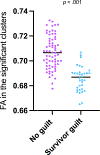Posttraumatic survivor guilt is associated with white matter microstructure alterations
- PMID: 38897303
- PMCID: PMC12322324
- DOI: 10.1016/j.jad.2024.06.047
Posttraumatic survivor guilt is associated with white matter microstructure alterations
Abstract
Background: Military veterans with posttraumatic stress disorder (PTSD) commonly experience posttraumatic guilt. Guilt over commission or omission evolves when responsibility is assumed for an unfortunate outcome (e.g., the death of a fellow combatant). Survivor guilt is a state of intense emotional distress experienced by the weight of knowing that one survived while others did not.
Methods: This study of the Translational Research Center for TBI and Stress Disorders (TRACTS) analyzed structural and diffusion-weighted magnetic resonance imaging data from 132 male Iraq/Afghanistan veterans with PTSD. The Clinician-Administered PTSD Scale for DSM-IV (CAPS-IV) was employed to classify guilt. Thirty (22.7 %) veterans experienced guilt over acts of commission or omission, 34 (25.8 %) experienced survivor guilt, and 68 (51.5 %) had no posttraumatic guilt. White matter microstructure (fractional anisotropy, FA), cortical thickness, and cortical volume were compared between veterans with guilt over acts of commission or omission, veterans with survivor guilt, and veterans without guilt.
Results: Veterans with survivor guilt had significantly lower white matter FA compared to veterans who did not experience guilt (p < .001), affecting several regions of major white matter fiber bundles. There were no significant differences in white matter FA, cortical thickness, or volumes between veterans with guilt over acts of commission or omission and veterans without guilt (p > .050).
Limitations: This cross-sectional study with exclusively male veterans precludes inferences of causality between the studied variables and generalizability to the larger veteran population that includes women.
Conclusion: Survivor guilt may be a particularly impactful form of posttraumatic guilt that requires specific treatment efforts targeting brain health.
Keywords: DTI; Moral injury; Posttraumatic stress disorder; dMRI; veterans.
Copyright © 2024 Elsevier B.V. All rights reserved.
Conflict of interest statement
Declaration of competing interest The other authors disclose no financial or other biomedical interests or potential conflicts of interest. Disclosure Dr. Koerte is a professor at Ludwig-Maximilians-Universität Munich (paid position). She serves as European Editor at Journal of Neurotrauma (unpaid position) and as Vice President of the European Neurotrauma Organization (unpaid position). She receives research grant funding from the National Institutes of Health, the European Research Council, the German Ministry for Research and Education. She receives funding for a research study on sport-related concussion from Abbott Inc. The Ludwig-Maximilians-University hospital received donations for her research from the Schatt Foundation and from Mary Ann Liebert Inc. She receives royalties for book chapters published by Thieme Publishers. Her spouse is employee at Siemens and she thus holds stock options at Siemens and Siemens Healthineers. Dr. Koerte's in-kind contributions: PhD students working under her supervision receive scholarships from the Villigst Foundation, the Konrad Adenauer Foundation, the Studienstiftung des deutschen Volkes, the China Scholarship Council collaboration with Ludwig-Maximilians-University Munich, the Harvard Munich Club, and Fulbright. Dr. Shenton is Professor of Psychiatry and Radiology at Harvard Medical School and is employed by Brigham and Women's Hospital. She has grant funding from the National Institute of Mental Health and formerly from VA Merit Awards and from the National Institute of Neurological Diseases and Stroke. She serves on the editorial board of several professional journals (unpaid), on NIH study sections (Honoria minimum), and she receives royalties for book chapters and books published by Thieme Publishers, Elsevier, and Cambridge University Press (minimal). She receives funding also for legal cases as a consultant and an expert witness related to mild traumatic brain injury and the use of diffusion tensor imaging in the courtroom. Dr. Shenton's in-kind contributions include PhD, MD, MD-PhD trainees and junior faculty working under her mentorship, many of whom have received K awards and grant support for their research. Dr. Kaufmann received speaker honoraria and financial compensation for travel expenses from Medtronic, UCB, Livanova, and Eisai and has participated in clinical trials for Medtronic, UCB and Precisis, all unrelated to the submitted work. Her research is supported by the Medical Clinical Scientist Program (MCSP). Tim Wiegand receives author royalties from ELSEVIER publishers.
Figures



Similar articles
-
Intimate partner violence perpetration among veterans: associations with neuropsychiatric symptoms and limbic microstructure.Front Neurol. 2024 May 31;15:1360424. doi: 10.3389/fneur.2024.1360424. eCollection 2024. Front Neurol. 2024. PMID: 38882690 Free PMC article.
-
Sexual Harassment and Prevention Training.2024 Mar 29. In: StatPearls [Internet]. Treasure Island (FL): StatPearls Publishing; 2025 Jan–. 2024 Mar 29. In: StatPearls [Internet]. Treasure Island (FL): StatPearls Publishing; 2025 Jan–. PMID: 36508513 Free Books & Documents.
-
The Black Book of Psychotropic Dosing and Monitoring.Psychopharmacol Bull. 2024 Jul 8;54(3):8-59. Psychopharmacol Bull. 2024. PMID: 38993656 Free PMC article. Review.
-
The relationship between blast-related mild traumatic brain injury and executive function is moderated by white matter integrity.Brain Imaging Behav. 2024 Aug;18(4):764-772. doi: 10.1007/s11682-024-00864-z. Epub 2024 Mar 6. Brain Imaging Behav. 2024. PMID: 38448704
-
Repetitive transcranial magnetic stimulation for post-traumatic stress disorder in adults.Cochrane Database Syst Rev. 2024 Aug 2;8(8):CD015040. doi: 10.1002/14651858.CD015040.pub2. Cochrane Database Syst Rev. 2024. PMID: 39092744 Free PMC article.
References
MeSH terms
Grants and funding
LinkOut - more resources
Full Text Sources
Medical
Miscellaneous

